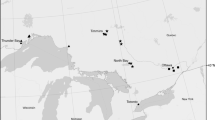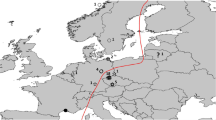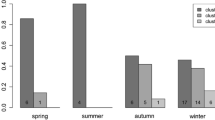Abstract
In western Europe, the coasts of Vendée and Charente-Maritime on the central Atlantic shoreline of France constitute the most southern wintering site for the Red Knot Calidris canutus islandica, welcoming around 37,000 individuals each winter, and also represent a key stopover area for C. c. canutus (up to 60,000 individuals) between Africa and the Wadden Sea in spring. Nevertheless, the origin of the birds in France arriving in the autumn is unclear, considering that the first islandica start to appear for wintering while canutus could use the same sites as a stopover on their migration route to Africa. We used biometric data from birds caught between 1983 and 2008 to assess the origin of Red Knot staging and wintering in France, and we also investigated the age structure of Red Knot groups during three distinctive periods of their biological cycle: autumn migration, wintering and spring migration. This first assessment was completed by data analysis of ring recoveries over a period of 44 years and isotopic ratio signatures of feathers. The obtained results were in conformity with the general patterns of distribution throughout the year and the timing of migration of both subspecies in Europe as described in previous reviews. Nevertheless, this study highlights two unknown features for both subspecies in this part of their European area distributions. First, a very large predominance of juveniles was recorded at the expense of an extreme rarity of adults in autumn and early winter. We prove the presence of canutus-knots among these juveniles, even with staging later in the autumn and the possibility of wintering there for some of them. Although the Atlantic coast of France welcomes only 9% of the population of islandica-knots wintering in Europe, this network of estuarine bays could represent a crucial strategic area for juveniles. The place could constitute a liberated area for islandica juveniles coming later than adults already settled in northern sites. It offers the possibility for canutus to migrate south on distance-limited stages in order to experiment with the flyway and refuel to join the traditional African wintering grounds.
Zusammenfassung
In Westeuropa stellen die Küsten von Vendée und Charente-Maritime an der zentralatlantischen Küste von Frankreich das südlichste Überwinterungsgebiet für die Knutt-Unterart Calidris canutus islandica dar, wo sich jeden Winter etwa 37.000 Individuen versammeln. Sie sind außerdem ein wichtiges Rastgebiet für die Unterart C. c. canutus (bis zu 60.000 Individuen) auf ihrem Zug zwischen Afrika und dem Wattenmeer im Frühjahr. Dennoch ist die Herkunft der Vögel, die im Herbst in Frankreich eintreffen, unklar, wenn man bedenkt, dass die ersten islandica-Knutts zum Überwintern ankommen, während canutus-Knutts dieselben Gebiete als Rastplätze auf ihrem Zug nach Afrika nutzen könnten. Wir haben biometrische Daten von zwischen 1983 und 2008 gefangenen Vögeln verwendet, um die Herkunft in Frankreich rastender und überwinternder Knutts festzustellen. Auch haben wir die Altersstruktur von Knuttgruppen während dreier unterschiedlicher Phasen in ihrem biologischen Zyklus untersucht: Herbstzug, Überwintern und Frühjahrszug. Diese erste Einschätzung wurde durch eine Datenanalyse von Ringwiederfunden über einen Zeitraum von 44 Jahren und Isotopensignaturen von Federn ergänzt. Die gewonnenen Ergebnisse stimmten mit den allgemeinen Verbreitungsmustern über das Jahr und der zeitlichen Koordinierung des Zuges der beiden Unterarten in Europa überein, wie sie in früheren Übersichtsartikeln beschrieben worden waren. Dennoch hebt diese Studie zwei bislang unbekannte Besonderheiten für beide Unterarten in diesem Teil ihres europäischen Verbreitungsgebietes hervor. Erstens wurde im Herbst und Frühwinter ein starkes Überwiegen juveniler Tiere auf Kosten adulter Vögel, die extrem selten waren, festgestellt. Zudem erbringen wir den Nachweis für die Anwesenheit von canutus-Knutts unter diesen juvenilen Tieren, auch solchen, die später im Herbst rasten und für welche die Möglichkeit zur dortigen Überwinterung besteht. Obwohl die französische Atlantikküste lediglich 9% der in Europa überwinternden islandica-Knutts beherbergt, könnte dieses Netzwerk ästuarer Buchten ein für juvenile Tiere äußerst wichtiges Gebiet sein. Es könnte ein freies Areal für Juvenile, die später kommen als Altvögel, welche sich bereits in den nördlichen Gebieten niedergelassen haben, darstellen. Es bietet die Möglichkeit für canutus-Knutts, auf Etappen begrenzter Entfernung nach Süden zu ziehen, um mit den Zugwegen zu experimentieren und aufzutanken, um die traditionellen afrikanischen Überwinterungsgebiete zu erreichen.







Similar content being viewed by others
References
Alerstam T (1990) Bird migration. Cambridge University Press, Cambridge
Atkinson PA, Baker AJ, Bevan RM, Clark NA, Cole KB, Gonzalez PM, Newton J, Niles LJ, Robinson RA (2005) Unravelling the migration and moult strategies of a long-distance migrant using stable isotopes: red knot Calidris canutus movements in the Americas. Ibis 147:738–749
Blew J, Südbeck P (2005) Migratory waterbirds in the Wadden Sea 1980–2000. Wadden Sea Ecosystem no. 20. Common Wadden Sea Secretariat, Trilateral Monitoring and Assessment Group & Joint Monitoring Group of Migratory Birds in the Wadden Sea, Wilhelmshaven
Boyd H (1992) Arctic summer conditions and British Knot numbers: an exploratory analysis. Wader Study Group Bull 64 (Suppl.):144–152
Boyd H, Piersma T (2001a) Changing balance between survival and recruitment explains population trends in red knots Calidris canutus islandica wintering in Britain, 1969–1995. Ardea 89:301–317
Boyd H, Piersma T (2001b) Why do few Afro-Siberian knots Calidris canutus canutus now visit Britain? Bird Study 48:147–158
Cramp S, Simmons KEL (1983) The birds of the Western Palearctic. Vol 3. Waders to gulls. Oxford University Press, Oxford
Davidson NC, Piersma T (2009) red knot, Calidris canutus. In: Delany S, Scott D, Dodman T, Stroud D (eds) An atlas of wader populations in Africa and Western Eurasia. Wetlands International and Wader Study Group, pp 362–368
Davidson NC, Wilson JR (1992) The migration system of European-wintering knots Calidris canutus islandica. Wader Study Group Bull 64(Suppl.):39–51
Deceuninck B, Mahéo R (2000) Synthèse des dénombrements et analyse des tendances des limicoles hivernant en France 1978–1999. Ligue pour la Protection des Oiseaux, Wetlands International, Paris
Deceuninck B, Mahéo R, Gabillard F (2008) Wader population estimates in France resulting from the 1997/1998 non-estuarine coastal waterbird survey. In: Rehfisch NHK, Stroud DA, Spary CJ (eds) The European non-estuarine coastal waterbird survey. International Wader Study Group 18, Thetford, pp 23–30
Dick WJA, Pienkowski MW, Waltner M, Minton CDT (1976) Distribution and geographical origins of knot Calidris canutus wintering in Europe and Africa. Ardea 64:22–47
Eisma D (1998) Intertidal deposits: river mouths, tidal flats, and coastal lagoons. CRC Press, Boca Raton
Engelmoer M, Roselaar CS (1998) Geographical variation in waders. Kluwer, Dordrecht
Evans PR (1986) Correct measurements of the wing length of waders. Wader Study Group Bull 48:11
Gromadzka J (1992) Knots on the Polish Baltic coast. Wader Study Group Bull 64(Suppl.):161–166
Gudmundsson GA (1994) Spring migration of the knot Calidris c. canutus over southern Scandinavia, as recorded by radar. J Avian Biol 25:15–26
Gudmundsson GA, Lindström Å, Alerstam T (1991) Optimal fat loads and long-distance flights by migrating knots Calidris canutus, sanderlings c. alba and turnstones Arenaria interpres. Ibis 133:140–152
Helseth A, Lindström Å, Stervander M (2005) Southward migration and fuel deposition of red knots Calidris canutus. Ardea 93:213–224
Kojadinovic J, Ménard F, Bustamante P, Cosson RP, Le Corre M (2008) Trophic ecology of marine birds and pelagic fishes from Reunion Island as determined by stable isotope analysis. Mar Ecol Prog Ser 361:239–251
Koopman K (2002) Mass, moult, migration and subspecific status of red knots Calidris canutus on the Frisian Wadden Sea coast, the Netherlands. Wader Study Group Bull 97:30–35
Leyrer J, Bocher P, Robin F, Delaporte P, Goulevent C, Joyeux E, Meunier F, Piersma T (2009) Northward migration of Afro-Siberian knots Calidris canutus canutus: high variability in red knot numbers visiting stopover sites on French Atlantic coast (1979–2009). Wader Study Group Bull 119:145–151
Mahéo R (2008) Limicoles séjournant en France (Janvier) 1977–2008. Wetlands International/ONCFS/Université de Rennes, Rennes, France
Meissner W (2004) Variability in the size of juvenile red knots Calidris canutus canutus. Wader Study Group Bull 103:71–74
Meissner W (2007) Stopover strategy of adult and juvenile red knots Calidris c. canutus in the Puck Bay, southern Baltic. Ardea 95:97–104
Meissner W, Kamont P (2005) Seasonal changes in body size and mass of red knots Calidris canutus during autumn migration through southern Baltic. Ornis Svec 97:97–104
Meltofte H (1996) Are African wintering waders really forced south by competition from northerly wintering conspecifics? Benefits and constraints of northern versus southern wintering and breeding in waders. Ardea 84:31–44
Morrison RIG, Wilson JR (1992) Observations of knot migration in Iceland 1970-1972. Wader Study Group Bull 64(Suppl.):101–109
Nebel S, Piersma T, van Gils JA, Dekinga A, Spaans B (2000) Length of stopover, fuel storage and sex-bias in the occurrence of red knots Calidris c. canutus and C. c. islandica in the Wadden Sea during southward migration. Ardea 88:165–176
Nehls HW (1987) Does the Nearctic Knot Calidris canutus islandica migrate through the southwestern Baltic? Wader Study Group Bull 51:53–55
Piersma T, Davidson NC (1992) The migrations and annual cycles of five subspecies of knots in perspective. Wader Study Group Bull 64(Suppl.):187–197
Piersma T, Bredin D, Prokosch P (1987) Continuing mysteries of the spring migration of Siberian knots: a progress note. Wader Study Group Bull 49:9–10
Piersma T, Prokosch P, Bredin D (1992) The migration system of Afro-Siberian k Calidris canutus canutus. Wader Study Group Bull 64(Suppl.):52–63
Piersma T, Hoekstra R, Dekinga A, Koolhaas A, Wolf P, Battley P, Wiersma P (1993) Scale and intensity of intertidal habitat use by knots Calidris canutus in the Western Wadden Sea in relation to food, friends and foes. Neth J Sea Res 31:331–357
Piersma T, Verkuil Y, Tulp I (1994) Resources for long-distance migration of knots Calidris canutus islandica and C. c. canutus: How broad is the temporal exploitation window of benthic prey in the western and eastern Wadden Sea. Oikos 71:393–407
Prater AJ, Marchant JH, Vuorinen J (1977) Guide to the identification and ageing of holarctic waders. BTO, Tring
Roselar CS (1983) Subspecies recognition in knot Calidris canutus and occurrence of the races in Western Europe. Beaufortia 33:97–109
Schekkerman H, Meininger PL, Lambeck RHD (1992) Knots in the delta area, southwest Netherlands. Wader Study Group Bull 64(Suppl.):175–181
Shamoun-Baranes J, Leyrer J, van Loon E, Bocher P, Robin Fdr, Meunier F, Piersma T (2010) Stochastic atmospheric assistance and the use of emergency staging sites by migrants. Proc R Soc Lond B 277:1505–1511
Stroud DA, Davidson NC, West R, Scott DA, Haanstra L, Thorup P, Ganter B, Delany S (2004) Status of migratory wader populations in Africa and Western Eurasia in the 1990s. Int Wader Stud 15:1–259
Summers RW, Underhill LG, Waltner M, Swann R (2010) Differences in biometrics and moult of non-breeding red knots Calidris canutus in southern Africa and Scotland reflect contrasting climatic conditions. Ibis 152:127–135
Thompson DR, Furness RW (1995) Stable-isotope ratios of carbon and nitrogen in feathers indicate seasonal dietary shifts in northern fulmars. Auk 112:493–498
Tomkovich PS (1992) An analysis of the geographic variability in knots Calidris canutus based on museum skins. Wader Study Group Bull 64(suppl.):17–23
Tomkovich PS, Soloviev MY (1996) Distribution, migrations and biometrics of knots Calidris canutus on Taimyr, Siberia. Ardea 84:85–98
Underhill LG, Waltner M, Summers RW (1989) Three-year cycles in breeding productivity of knots Calidris canutus wintering in southern Africa suggest Taimyr Peninsula provenance. Bird Study 36:83–87
Uttley JD, Thomas CJ, Davidson NC, Strann KB (1987) The spring migration of Nearctic knots Calidris canutus islandica: a re-appraisal. Wader Study Group Bull 49(Suppl.):80–84
van de Kam J, Ens BJ, Piersma T, Zwarts L (2004) Shorebirds. An illustrated behavioural ecology. KNNV, Utrecht
Velasco T, Alberto LJ (1993) Numbers, main lovalities and distribution maps of waders wintering in Spain. Wader Study Group Bull 70:33–41
Verger F (2005) Marais et estuaires du littoral français. Belin, Paris
Whitfield DP, Brade JJ, Burton RW, Hankinson KW, Young S (1996) The abundance of breeding knot Calidris canutus islandica. Bird Study 43:290–299
Wilson J, Dick WJA, Frivoll V, Harrison M, Soot KM, Stanyard D, Strann KB, Strugnell R, Swinfen B, Wilson R (2008) The migration of red knots through Porsangerfjord in spring 2008: a progress report on the Norwegian knot project. Wader Study Group Bull 115:171–176
Wood AG (1988) Discriminant and graphical analyses of Norwegian knot biometrics: the sex and race problem revisited. Wader Study Group Bull 52:9–10
Wymenga E, Engelmoer M, Smit CJ, van Spanje TM (1990) Geographical breeding origin and migration of waders wintering in West Africa. Ardea 78:83–112
Yesou P (1992) Importance de la baie de l’aiguillon et de la pointe d’Arçay (Vendée, France) pour les limicoles. L’Oiseau RFO 62:213–233
Acknowledgments
The catches on study sites were only possible with the precious help of numerous people from The National Nature Reserves and volunteers. We would like to thank the staff of the Nature Reserves of Marais d’Yves, Lileau des Niges, Baie de l’Aiguillon and Moëze-Oléron. We particularly thank Julien Gonin, Pierre Rousseaux, Fréderic Corre and Nicolas Boileau.
Author information
Authors and Affiliations
Corresponding author
Additional information
Communicated by F. Bairlein.
Rights and permissions
About this article
Cite this article
Bocher, P., Quaintenne, G., Robin, F. et al. Origins and age structure of Red Knot Calidris canutus staging and wintering on the Atlantic coast of France. J Ornithol 153, 103–114 (2012). https://doi.org/10.1007/s10336-011-0702-5
Received:
Revised:
Accepted:
Published:
Issue Date:
DOI: https://doi.org/10.1007/s10336-011-0702-5




